
Saint Twrog - feast day 26 June - was a 6th-century Welsh saint who founded the church at Maentwrog, having come to Wales early in the Age of the Saints.

Saint Twrog - feast day 26 June - was a 6th-century Welsh saint who founded the church at Maentwrog, having come to Wales early in the Age of the Saints.
It is believed that Twrog was the son of Ithel Hael o Lydaw of Brittany. He was also the brother of Saint Tanwg of Llandanwg, Saint Tecwyn of Llandecwyn, Saint Tegai of Llandegai and Saint Baglan of Llanfaglan and Baglan. [1]
He was a member of the college of Bardsey which was founded as a monastery in 516 AD.

There are three other dedications to Saint Twrog: Bodwrog in Anglesey (St Twrog's Church, Bodwrog), Llandwrog near Caernarfon, and the ruin on Chapel Rock near Beachley by the Severn Road Bridge.
When Twrog first arrived in the village now called Maentwrog, the valley was very marshy, which provided him with the wattle that he would have needed to build his cell. Outside the church near to the belfry door is a large stone known as the Maen Twrog (maen being the Welsh for stone). Twrog is reputed to have thrown the stone from the top of Moelwyn crushing a pagan altar in the valley below. It is said that his handprints can still be seen in the stone. The parish of Maentwrog gets its name from this stone [2]
In the book of Welsh mythology, the Mabinogion, a hero Pryderi was killed at the Glaslyn river and is buried in Maentwrog. The boulder supposedly hurled by the saint is the one said to mark Pryderi's grave.

Aberavon is a town and community in Neath Port Talbot county borough, Wales. The town derived its name from being near the mouth of the river Afan, which also gave its name to a medieval lordship. Today it is essentially a district of Port Talbot, covering the central and south western part of the town. Aberavon is also the name of the nearby Blue Flag beach and the parish covering the same area.
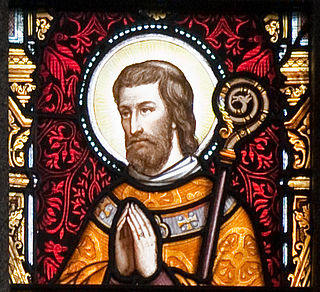
Saint Máedóc of Ferns, also known as Saint Aidan, Saint Madoc or Saint Mogue, was an Irish saint who was the first Bishop of Ferns in County Wexford and the founder of thirty churches. His birth name was Áed, the name of the Irish god of the underworld, meaning "fire". The name Aidan is a diminutive form of Aed or Aodh, and was also a form of the Latin name Dominus. Máedóc and Mogue are other pet forms of Aed or Aodh, formed from the Irish affectionate prefix mo- and the diminutive suffix -óg, meaning "young", making for something like "my dear little Aodh".
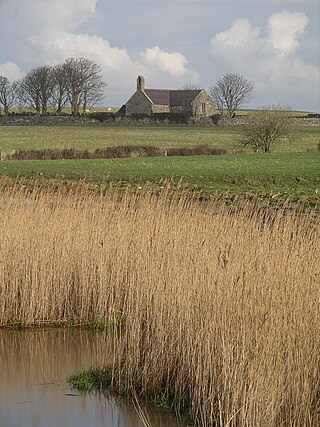
Llanfaglan is a parish in Gwynedd, north-west Wales. It lay in the medieval cwmwd of Is Gwyrfai.
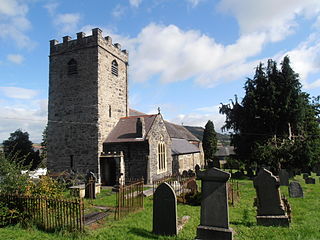
Saint Mael and Saint Sulien's Church is a church located in the town of Corwen in Denbighshire in Wales. It was formerly located in the ancient county of Merionethshire.

Baglan is a village in Wales, adjoining Port Talbot, named after Saint Baglan. It is also a community and ward in the Neath Port Talbot county borough. In 2001, the population was 6,654. rising to 6,819 in 2011.
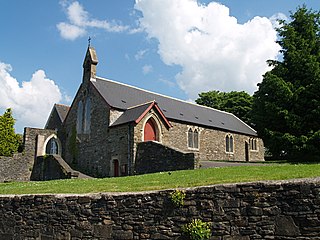
Birchgrove is a suburb and community in Swansea, Wales, United Kingdom. It is situated about 4.5 miles (7 km) north-east of Swansea city centre, between the flood plain of the River Tawe and Mynydd Drumau. The community of Birchgrove had a population of 7,392 in 2011.
Saint Baglan was a 6th-century hermit who lived at Baglan in Wales.

Maentwrog is a village and community in the Welsh county of Merionethshire, lying in the Vale of Ffestiniog just below Blaenau Ffestiniog, within the Snowdonia National Park. The River Dwyryd runs alongside the village. Its population of 585 in 2001 increased to 631 at the 2011 Census. The Community of Maentwrog includes the village of Gellilydan.
The Four Branches of the Mabinogi or Pedair Cainc Y Mabinogi are the earliest prose stories in the literature of Britain. Originally written in Wales in Middle Welsh, but widely available in translations, the Mabinogi is generally agreed to be a single work in four parts, or "branches." The interrelated tales can be read as mythology, political themes, romances, or magical fantasies. They appeal to a wide range of readers, from young children to the most sophisticated adult. The tales are popular today in book format, as storytelling or theatre performances; they appear in recordings and on film, and continue to inspire many reinterpretations in artwork and modern fiction.
Llangolman is a village and parish in the southeastern Preseli Hills in Pembrokeshire, Wales. It is part of the community of Mynachlog-ddu. There are prehistoric remains nearby and the parish has a history of slate and clay quarrying.
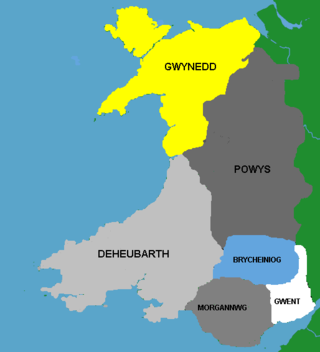
Glywys is a legendary early 5th century Welsh king, an important character in early Welsh genealogies as the eponymous founder king of Glywysing, a southeast Welsh kingdom whose heartland lay between the Tawe and the Usk.
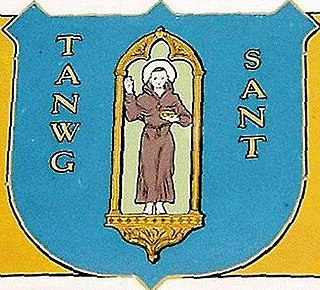
Saint Tanwg is the patron saint of Llandanwg, Gwynedd, Wales. He is presumed to be the founder of St Tanwg's Church, the small church at Llandanwg near Harlech, although the presence of an inscribed stone which has been dated to the 5th century suggests the church was already in existence when Tanwg and his brothers arrived in the area early in the 6th century. This Llandanwg Stone is inscribed with two names, one being Ingenui ; the other is indecipherable. The stone is not local. It is thought to have come from the Wicklow Hills in Ireland. This means that it was probably brought over by a rich person. It is a reasonable conjecture that Ingenuus may have been the founder of the church in the late fifth century, and that St. Tanwg lived at this llan a generation or two later. Another stone, called the Equester Stone, is of 6th century date. It is inscribed Equestrinomine, an unusual form of wording otherwise known only from 4th century inscriptions in Italy and Gaul.
Saint Cadfan, sometimes Anglicized as Gideon, was the 6th century founder-abbot of Tywyn and Bardsey, both in Gwynedd, Wales. He was said to have received the island of Bardsey from Saint Einion Frenin, king of Llŷn, around 516 and to have served as its abbot until 542.

Saint Twrog's Church is in the village of Maentwrog in the Welsh county of Gwynedd, lying in the Vale of Ffestiniog, within the Snowdonia National Park. It is in the Deanery of Ardudwy. It is designated by Cadw as a Grade II listed building.

Saint Tegai is the patron saint and founder of Llandygai in the Welsh county of Gwynedd.
Saint Tecwyn is the patron saint and founder of Llandecwyn in the Welsh county of Gwynedd.
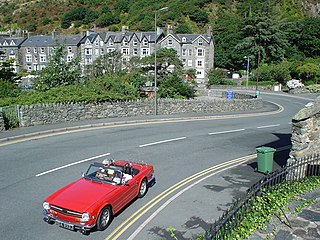
The A496 is a major coastal and mountainous road in southern Snowdonia.
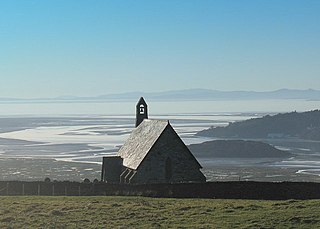
Llandecwyn is a hamlet near Penrhyndeudraeth in Gwynedd, Wales.

Efenechtyd is a hamlet and community in a deep valley in Denbighshire, Wales which contains the Church of St Michael and All Angels. The community includes the village of Pwllglas. Efenechtyd is also the name of an electoral ward.
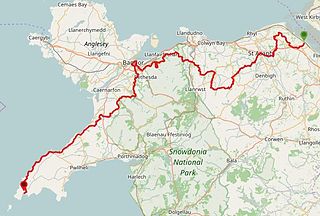
The North Wales Pilgrim's Way is a long-distance walking route in North Wales, running from near Holywell in the east to Bardsey Island in the west. The first half of the trail takes an inland route, with the second half following the north coast of the Llŷn Peninsula. It measures 133.9 miles (215 km) in length, and was officially launched at Porth y Swnt, Aberdaron on 10 July 2014.